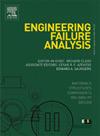从拉伸-剪切裂缝分离的角度研究不同含水量砂岩中的裂缝演变和破坏前兆预警
IF 4.4
2区 工程技术
Q1 ENGINEERING, MECHANICAL
引用次数: 0
摘要
为了研究水对砂岩裂纹演变和破坏模式的影响,使用不同含水量的样品进行了单轴压缩实验。基于声发射(AE)和数字图像相关(DIC)技术,研究了不同含水量砂岩的破坏演化过程。此外,还采用 RA-AF 分布法对裂缝演变过程进行了研究。结果表明,砂岩的脆性随着含水量的增加而减弱,单轴抗压强度(UCS)和弹性模量显著下降。剪切裂缝的百分比从干燥时的 21.1% 持续增加到饱和时的 36.53%,这些裂缝通过 AE 信号的演变与 DIC 观察结果密切相关。然而,水对这些裂缝发展的影响却大不相同。通过对两种裂缝的分离分析,砂岩的损伤演变规律更加清晰。根据临界减速理论(CSDT),拉伸和剪切裂缝信号发生突然波动的点可作为预警指标。不同含水率砂岩的预警点识别结果均处于裂缝扩展阶段,应力水平均接近 0.9,显示了可靠的预测能力。此外,通过分析拉伸和剪切裂缝出现和扩展的特征,解释了水对砂岩裂缝类型转变的影响机理以及加载初期和后期破坏模式的差异。本文章由计算机程序翻译,如有差异,请以英文原文为准。
Investigating crack evolution, and failure precursor warning in sandstones with different water contents from the perspective of tensile-shear crack separation
To investigate the effect of water on the crack evolution and damage mode of sandstone, uniaxial compression experiments were conducted using samples with different water contents. The damage evolution process of sandstones with different water contents was investigated based on acoustic emission (AE) and digital image correlation (DIC) techniques. Further, the crack evolution was conducted using the RA-AF distribution method. The results showed that the brittleness of sandstone weakened with increasing water content, and the uniaxial compressive strength (UCS) and elastic modulus decreased significantly. The percentage of shear cracks increased continuously from 21.1% when dry to 36.53% when saturated and the evolution of these cracks through AE signals correlates closely with DIC observations. However, the influence of water on the development of these cracks differs significantly. Through the separation analysis of the two types of cracks, the damage evolution law of sandstone is clearer. Based on the critical slowing down theory (CSDT), the point at which both tensile and shear crack signals undergo abrupt fluctuation serves as an early warning indicator. The early warning point identification results of the sandstone with different water contents are all in the crack extension stage, the stress levels are all near 0.9 and demonstrate reliable predictive capabilities. Furthermore, the mechanism of water’s impact on the transition of crack types and the differences in damage modes in sandstone during the initial and later loading stages is explained by analyzing the characteristics of tensile and shear crack emergence and expansion.
求助全文
通过发布文献求助,成功后即可免费获取论文全文。
去求助
来源期刊

Engineering Failure Analysis
工程技术-材料科学:表征与测试
CiteScore
7.70
自引率
20.00%
发文量
956
审稿时长
47 days
期刊介绍:
Engineering Failure Analysis publishes research papers describing the analysis of engineering failures and related studies.
Papers relating to the structure, properties and behaviour of engineering materials are encouraged, particularly those which also involve the detailed application of materials parameters to problems in engineering structures, components and design. In addition to the area of materials engineering, the interacting fields of mechanical, manufacturing, aeronautical, civil, chemical, corrosion and design engineering are considered relevant. Activity should be directed at analysing engineering failures and carrying out research to help reduce the incidences of failures and to extend the operating horizons of engineering materials.
Emphasis is placed on the mechanical properties of materials and their behaviour when influenced by structure, process and environment. Metallic, polymeric, ceramic and natural materials are all included and the application of these materials to real engineering situations should be emphasised. The use of a case-study based approach is also encouraged.
Engineering Failure Analysis provides essential reference material and critical feedback into the design process thereby contributing to the prevention of engineering failures in the future. All submissions will be subject to peer review from leading experts in the field.
 求助内容:
求助内容: 应助结果提醒方式:
应助结果提醒方式:


